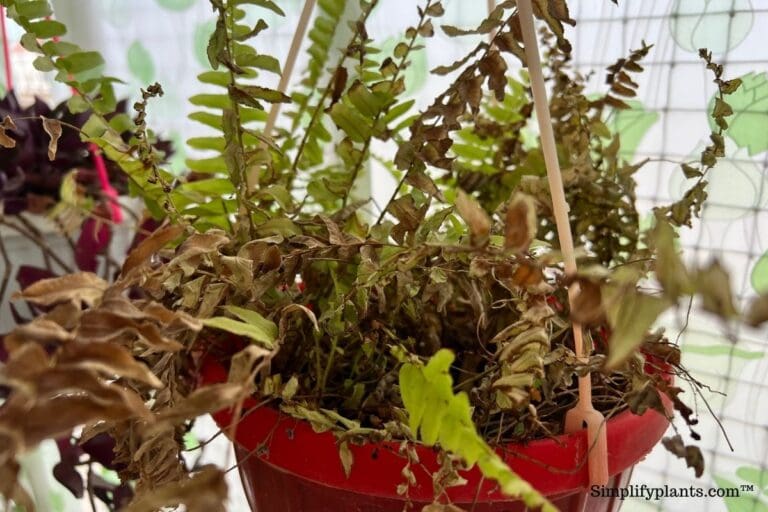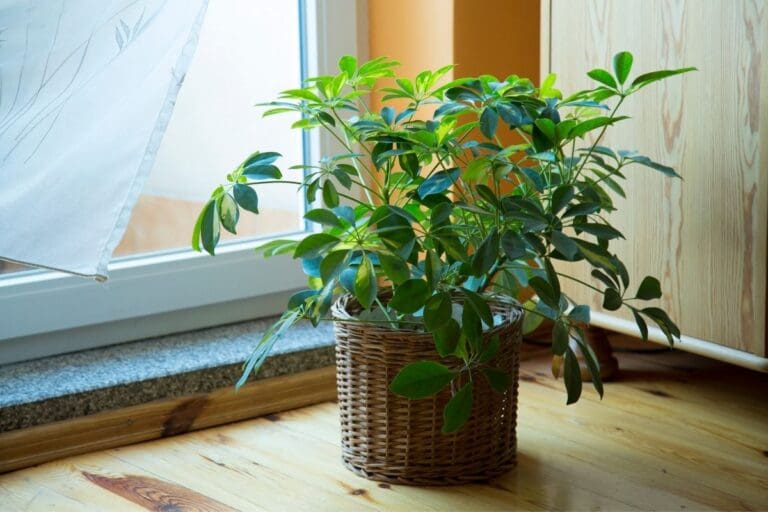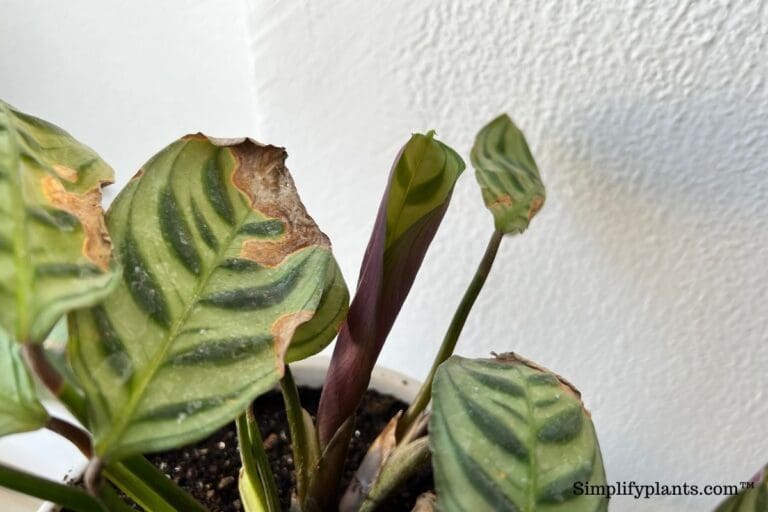When Can You Repot Croton Plant? (+How To Repot)
The early summer or spring is the best time to repot croton. But how would you know if you should repot your crotons or not?
In this article, we shall learn when can you repot croton plants and how to do the same.
Generally, you should repot a young croton plant every year during spring or summer at least for the first 2-3 years as they grow vigorously at that stage. After that, you must repot only when the plant show signs of being root bound, like roots emerging from the soil and drainage holes.
I have tried including all the information related to repotting a croton plant in this article.

Please note: Simplify Plants is reader-supported. Some links in the post are affiliate links and I get a commission from purchases made through links in the post.
How do I know when to repot my croton?
Repot croton only when it is necessary.
It is pointless to repot when the plant is healthy and not experiencing any stress, shock, or damage.
The best time for repotting croton is during the spring season or early summer when it is actively growing.
A plant needs repotting when the roots emerge from the drainage holes or when the roots are visible from the top of the soil.
There are other causes also that specify why repot is necessary.
Also read: Does Croton Like To Be Root Bound? (+When To Repot)
Providing additional space to the plant for growth
Croton usually grows to a height of 1-4 feet and width up to 5 feet as indoor plants.
Thus, for a tall and strong plant, a heavier pot is required to withstand the pressure.
A new pot larger in size and diameter also provides enough space for the croton plant while growing.
For the first 3 to 4 growing seasons, you should repot croton. This will prevent the rootbound condition and stunted growth.
To add fresh soil after the existing one has run out of nutrients.

Over time soil for indoor plants lack nutrients.
Croton grown indoors have limited soil and nutrients, unlike those grown in the garden or outdoors.
Over the years, using the same soil will lack nutrients (even after fertilization, the soil quality degrades).
To provide the best quality soil filled with nutrients, repotting is necessary.
Moreover, if the soil has been previously over-fertilized, it is better to remove it.
Diseases associated with roots
The two most common diseases related to roots are croton getting root-bound or root rot.
When the roots of a croton plant are grown mature than the size of the pot, it becomes root-bound.
Plants suffering from prolonged root bound states can experience dehydration and nutrition deficiency.
Root rot is caused due to overwatering.
The roots get suffocated due to insufficient passage of oxygen within them.
The symptoms of root rot are:
- Wilted leaves
- Discoloration
- Stunted growth
- The premature dropping of leaves
- Foul-smelling soil.
Over-use of fertilizers

The fertilizers used for croton are generally acidic and rich in nitrogen and phosphorus.
So, overuse of such chemicals can deteriorate the condition of the soil.
Over-fertilization soaks up water from the stem, thus dehydrating it further.
Some common symptoms of over-fertilization are brown, wilted leaves, weak stems, and a dry plant.
Soil transfer is the only possible way to revive a plant damaged due to over-fertilization.
Also read: What Fertilizer Is Good For Croton? (Best Fertilizer For Croton Plant)
What do you need to repot croton?
While repotting a croton plant, the process should be fast and smooth.
So, one must have all the things arranged prior.
If we leave the uprooted plant outside the soil for too long, it might lose all the energy and start drying.
Things needed for repotting:
- Perfect sized pot with drainage holes
- Potting soil mix for croton
- Knife or any object to clean the roots
- Clean cloth to keep the uprooted plant
- Water
- Fertilizer (if needed)
How to repot croton plants?
Repotting a plant is not as easy as it seems.
One must choose the right sized pot and suitable soil mix and be familiar with repotting techniques.
For ensuring a successful repotting session, we have thoroughly mentioned all the ways.
Choosing a perfect sized pot
We need to gather a few things before repotting the croton, and a correct-sized pot is one of them.
A pot should be one to two inches bigger in diameter than the pot you are currently using.
While choosing a pot, keep in mind that crotons can grow tall.
So, light or small pot might not hold the plant straight due to its weight.
A drainage hole is mandatory at the bottom of the pot, as it will drain the excess water.
Crotons cannot withstand too much water.
To prevent the soil from getting washed from the hole, partially cover it with cement or a piece of broken pot.
Pots made of terracotta and clay are better than stone, ceramic, plastic, or marble.
Also read: What Kind Of Pot For Croton? (Pot Size, Material & More)
Removing the croton plant from the previous pot
Tilt the pot upside down, hold the plant and gently tap at the bottom to remove the plant quickly.
If the croton is stuck, there are two possible ways to pull it out.
Either make the soil moist to drain or use a knife to take it out smoothly.
It is better if you don’t forcefully pull out the plant. The stem and roots can get damaged while pulling out forcefully.
Detangle the roots of your croton
Gently untie the roots of your croton using your fingers, be careful, so you don’t damage any of them.
Shake the roots gently to make them soil-free.
If the old soil has lost its nutrients with time or is damaged due to overuse of fertilizers, the only best solution is soil transfer.
Arranging the pot with soil mix

Take some regular household soil (you must select the amount according to the size of the pot) and mix perlite and peat moss with it.
You can also add some fertilizers to make the soil rich if needed.
Now fill the pot to one inch from the rim of the new pot.
The croton’s root nodes must dip inside the soil thoroughly.
The ideal soil mix for croton has to be rich and heavy, and it should not hold the water.
Also read: What Kind Of Soil Does A Croton Need? (+Ideal Soil Mix & Requirements)
Place the croton in the new pot
Now, when the pot is ready with soil, it’s time to sow the croton plant in it.
Hold the roots in the center of the pot and add the soil mix.
Cover the root balls.
Gently press the soil down towards the pot to evenly spread it.
But don’t place it tightly, as a tight soil mix will prevent oxygen flow within the roots.
Water after repotting
The first watering you do after repotting is vital.
Water the plant until it runs through the drainage hole, moistening the whole soil.
Also, carefully drain the excess water out of the pot.
It should not stay inside the pot clogging the roots.
The lower parts of the soil should not experience staying water.
Also read: How Often To Water Croton Plant? (Watering Schedule+Watering Problems)
Feeding the newly repot croton plant.

For croton, fertilizers rich in nitrogen and phosphorous are more suitable as they induce growth hormones and make the leaves colorful.
The ideal NPK (Nitrogen: Phosphorus: Potassium) ratio is 3:1:2 and 8:2:10.
Since croton prefers slightly acidic soil, feed your plant with fertilizers that have ammonium sulfate, ammonium nitrate, or urea coated with sulfur.
But while using fertilizers, be careful so you don’t harm your plant.
Keep in mind if the main reason behind repotting your plant is overuse of fertilizers, then don’t feed it.
And also, don’t fertilize croton during winters.
Also read: What Fertilizer Is Good For Croton? (Best Fertilizer For Croton Plant)
Taking care of the newly potted plant
Usually, a repot session is a stressful experience for any plant.
To relieve them from the sudden shock, we need to replicate the ideal growing conditions for croton.
After repotting the plant, you should keep it under direct sun, and the surrounding atmosphere must have humidity levels ranging between 30% to 70%.
Final words

A successful repot doesn’t end the process. After repotting, it is vital to take proper care. As the plant has just experienced a massive change in its environment, it remains stressed for a while before it recovers.
Keep the croton under direct sun or bright light. Better to keep it near a window or balcony. Water it thoroughly, only once or twice every week is enough. But never keep the plant dry.
These are heavy feeders. Therefore, little water-based fertilizer will add benefits. And lastly, do not disturb the plant pot for a month or two. Let it understand the new surrounding and shape itself according to them.
FAQs
Do crotons grow well in pots?
Crotons grow well both as outdoor plants and in pots. But it needs a little attention from your end.
Full sun for 6 hours, watering after the topsoil gets dry, warm and humid condition, fertilize as per the season, and check the croton to make sure it is doing well.
Along with these, proper pruning and timely repotting will make the croton thrive even in a pot.
Does croton need direct sunlight?
Crotons need direct sunlight for at least 6 hours every day, but some species prefer bright indirect sunlight.
You must keep your croton away from too intense sunlight in the afternoons and low light areas.
Also read: What Kind Of Light Does A Croton Need? (Croton Light Requirements )
Reference: Sciencedirect, Wikipedia, Wikipedia, Britannica, CABI, Academia, University of South Florida, The University of Georgia.
Recommended Garden Supplies
| Product Image | Our Recommended Gardening Supplies | Check Offers! |
|---|---|---|
Top Top
Top
Top
Top
Top
Top
Top
Top | rePotme Houseplant and Tropical Classic Potting Soil Mix | Check Offer On Amazon |
 Top
Top
Top
Top
Top
Top
Top
Top | Espoma Organic Indoor Plant Food | Check Offer On Amazon |
 Top
Top
Top
Top
Top
Top
Top
Top | GooingTop LED Grow Light 6000K Full Spectrum Clip Plant Growing Lamp | Check Offer On Amazon |
 Top
Top
Top
Top
Top
Top
Top
Top | Soil Moisture Meter | Check Offer On Amazon |
 Top
Top
Top
Top
Top
Top
Top
Top | Govee Hygrometer Thermometer, Bluetooth Enabled! | Check Offer On Amazon |
 Top
Top | LEVOIT Humidifiers for Large Room(Best For Plants) | Check Offer On Amazon |
 Top
Top
Top
Top
Top
Top
Top
Top | Upgraded DIY Automatic Drip Irrigation Kit, 15 Potted Houseplants Support | Check Offer On Amazon |
 Top
Top
Top
Top
Top
Top
Top
Top | Stainless Steel Heavy Duty Gardening Tool Set | Check Offer On Amazon |
 Top
Top
Top
Top
Top
Top
Top
Top | Bonide Insecticidal Soap | Check Offer On Amazon |
 Top
Top
Top
Top
Top
Top
Top
Top | Bonide 32 oz Spray Neem Oil for Organic Gardening | Check Offer On Amazon |
 Top
Top
Top
Top
Top
Top
Top
Top | Garden Safe Fungicide | Check Offer On Amazon |








I have one now that is about 6 ft. tall and is in desperate need of repotting. The main stems are bare with quite a few nodes that do produce leaves. Wondering how deep I should plant her?
When repotting your plant, you should aim to plant it at the same depth it was in the previous pot. Avoid burying the main stems deeply, as this could cause them to rot. If there are nodes that can produce leaves, make sure they are above the soil level to encourage new growth. Good luck with your repotting!